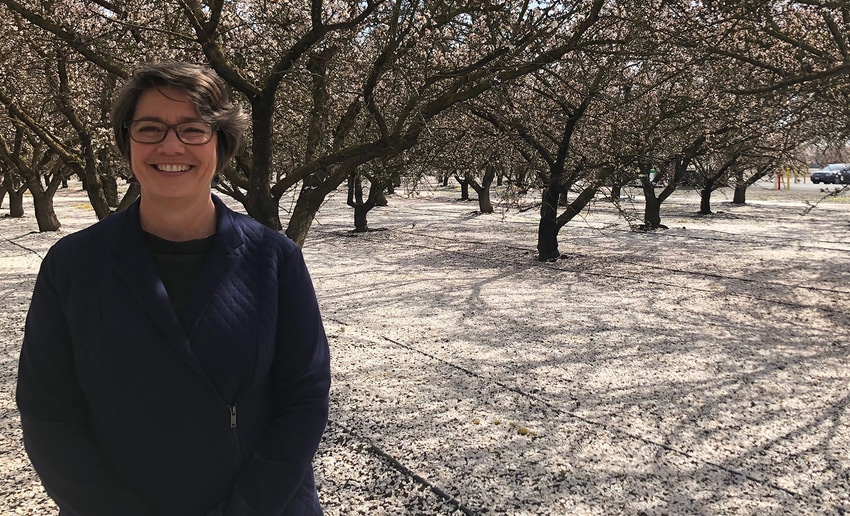
The Spring 2020 almond industry showcase to illustrate economic benefits and environmental stewardship was among the COVID-19 cancellation casualties. Almond Alliance President Elaine Trevino was hoping to demonstrate for policy makers "all the components and complexities of the California almond industry and its sustainability and innovation," she said.
Those presentations will have to wait until the alliance’s sister organization, the Almond Board of California, holds its annual conference in December at Cal Expo (Dec. 8-10).
In the interim, work is ongoing with ABC’s ambitious four-part Almond Orchard 2025 Goals project "to make life better in what we grow and how we grow it," according to ABC Board Chair Holly King.
"For the first time," she announced in January 2019, "we publicly commit to specific objectives. And while we anticipate progress won’t always be linear — we’ll experience advancements and setbacks as we go — we’re as agile as we are determined."
Specifically, the California almond community (7,600 growers and processors employing over 100,000 workers caring for 1.2 million acres of almonds generating in excess of $21 billion in economic revenue as the state’s top agricultural export) wants to do things better.
To wit, the 2025 program goals — a 20% reduction in the amount of water used to grow almonds; a 50% reduction of dust during harvest; a 25% increase in the use of environmentally friendly pest management tools, and zero orchard waste by putting everything to optimal use.
"These are ambitious goals, but the almond industry prides itself on forward thinking," says molecular biologist Josette Lewis, ABC’s chief scientific officer. "Being bold and pushing ourselves as an industry is an important part of being a grower’s crop choice."
Here’s the project timeline.
Three-year average of statistics
"We’re going to take a three-year rolling average of statistics to use as a baseline, keeping in mind the impact that weather has on these stats," she said. "How much irrigation water we use has to do with what the spring rains looked like and pest management is impacted by a wet spring. We’ll have our baseline calculations in the next month and we can determine what a 20% variation in water efficiency will look like and how that might impact pest management."
One of the most ambitious goals is a 50% reduction in harvest dust and that’s a big leap. "Dust reduction efforts suggest we may need some amount of off-ground harvesting, altering the ground carpet process, to achieve that goal."
Equally challenging will be the goal of zero waste. "We now sell a lot of hulls and shells to the dairy industry, but we’re looking for some higher value opportunities to take some promising technologies to scale and that represents both an opportunity as well as a challenge. We’re working on trying to palletize hulls for the Chinese animal feed industry and that’s challenging on so many fronts."
Whole orchard recycling is another concept designed to deal with the large biomass when an orchard is taken down.
"That’s a great opportunity for us, but it’s a once-in-a-25-year cycle, so we’ve got to work fast to get information out to growers on how to adopt that practice," said Lewis, who was promoted from being the ABC’s director of agricultural affairs earlier this year.
Because honeybees help pollinate 82% of the world’s almonds, there’s a section involving bees under the environmentally friendly pest management topic. "We want to make sure we’re not creating risks for bees, basing our actions on 20 years of research funded by the Almond Board — things like creating better bee habitat via cover crops. That’s some additional study we’ll be doing this year on top of our four main goals."
When you’re close to, if not the, largest acreage crop in the state, you can be pretty sure you are constantly in the eyes of both policy makers and consumers. "It’s important we hold up the highest standards so we continue to be seen as a valuable part of the California economy and environment," Lewis says.
The Almond Board will be making periodic progress reports on their goals, wrapping up by early 2026 in order to capture data from the final 2025 growing season.
"We’ll also have smaller ways of measuring progress through publication of best management practices as outreach to growers, keeping the market ahead of supply as new acreage comes onboard," Lewis noted.
For more news on tree nuts as reported by growers and farm advisors, subscribe to the Tree Nut Farm Press e-newsletter.
About the Author(s)
You May Also Like




